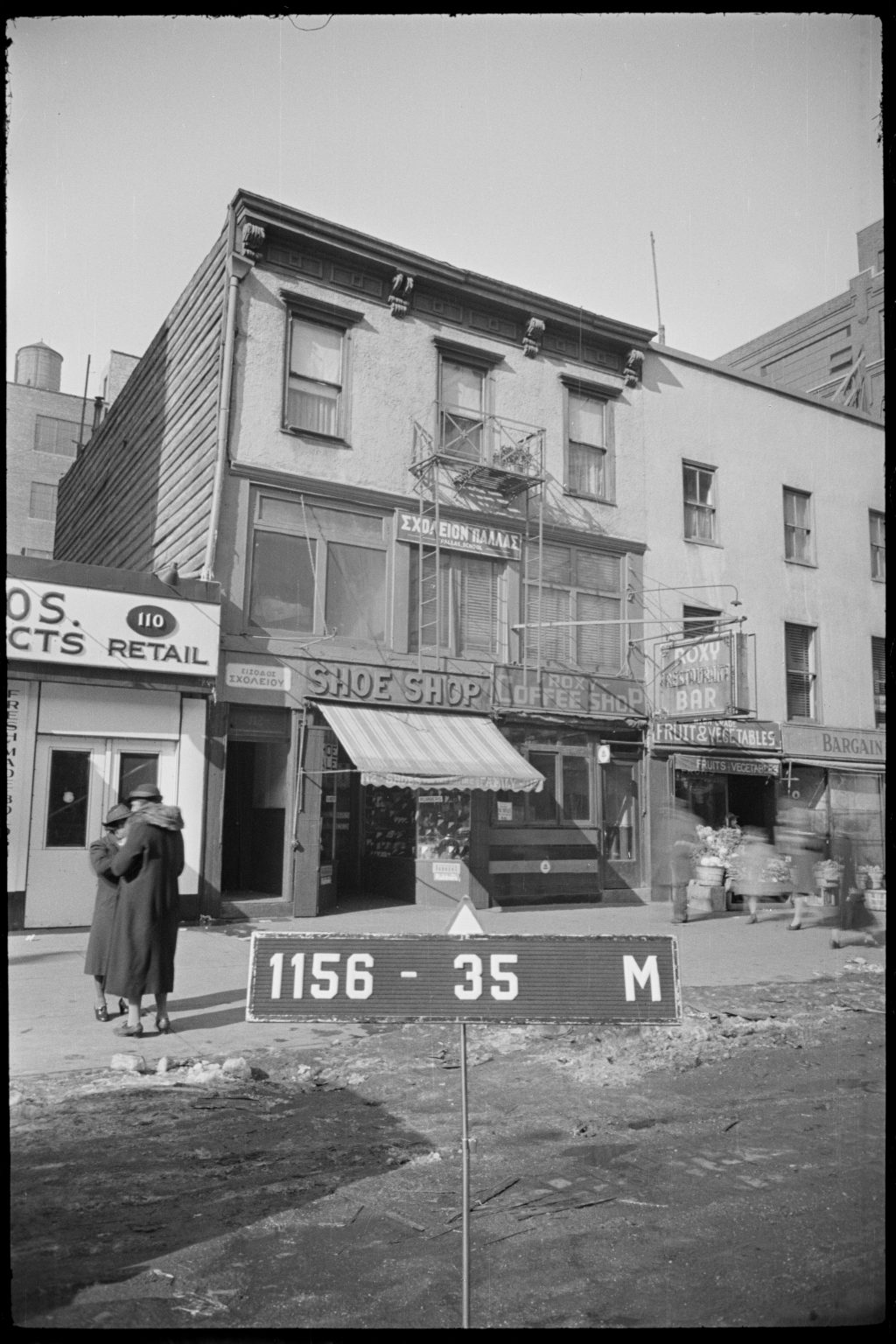 By Claudie Benjamin
By Claudie Benjamin
Shoe stores, shoe repair shops, and shoe shine boys are part of the urban lore of the Great Depression and the decades following. Shoes are a necessity of daily living and walking on pavement. A serious shine on one’s shoes (unless they are sneakers) signals cleanliness and has long been a sign of self-respect.
Even today, a good shoemaker always returns shined shoes. But while repair shops still exist, they are far fewer in number. Some still have individual booths where customers receive “while-you-wait” service. And there are some gussied-up vintage restorations with boutique shoe shine services at upscale places like Chelsea Market. The shoeshine booths in train depots like Grand Central and Penn Station are almost entirely gone.
There were numerous shoe-related stores in San Juan Hill. At 112 Amsterdam Avenue, for example, a sign photographed around 1940 reads in bold, raised letters SHOE SHOP. Three blocks south in a 1937 photo looking west across Amsterdam Avenue and 62nd Street, a sign juts out that reads “Underpriced Cut Rate Shoes”. It hangs above an arrow pointing into the shop.
Shoes were most commonly made of leather at the time. They would need regular repair and care. Man-made imitation leather used for shoes before the 1930s had emerged most prominently in Germany, but polyurethane used to enhance shine, durability, and to lower cost was not widely available in the United States until the 1960s. Shiniest of all, patient leather was also first produced in Germany, and then in the U.S. as early as 1816. “Simply put, it’s real leather that’s been coated with varnish to give it a glossy finish.” (1) So, shoes made with artificial tops or specially treated leathers either stay shined or can be easily cleaned at home with a cloth, brush, and a bit of polish.

View of Amsterdam Avenue at West 62nd Street by Percy Loomis Sperr. Image Copyright New York Public Library, used with permission.
Neighborhood shoe stores were convenient by definition. They have dramatically declined in number, losing out in competition to online offerings. Purchasing online shoes, boots, or sneakers may all be much less expensive, a particular plus for today’s customers who often buy multiple pairs at a time and may enjoy customer-friendly free delivery, quick buy & return policies.
Historically, a visit to a neighborhood shoe store involved a clerk measuring the customer’s foot and retrieving one or several models selected from a display to be tried on. There was no self-service.
Combat boots, at least through WW II, were made of leather and were part of the uniform given to millions of service people. Soldiers were expected to keep their boots highly shined – a practice they likely applied to footwear after the war.
WW II era newsreel clips frequently showed columns of boots superimposed on maps. They marched with the rumble of bombers overhead through the rutted roads of rural France and routes of the Ardennes, Southern Italy, and North Africa.
Back on the home front of the Upper West Side, as throughout NYC and the US, the war reverberated in what people wore on their feet. Shoes were among other non-food items rationed during the war.
“Rubber boots were rationed as early as October 1942 to save on rubber usage. On February 7, 1943, with only a couple of days’ notice, leather footwear joined the ration list. Both leather and rubber from shoe soles was needed for the war. As well as rationing shoe quantity, the OPA [Office of Price Administration] limited the colors of shoes available. Only black, white, “town brown,” and “army russet” could be made and sold…” (2)
Shoe polish in cream form was sold in round metal palm-sized canisters (some are still stocked) at shoe repair shops for at-home use. The polish came mostly in black, brown, and neutral. Liquid white polish came in jars with a padded applicator for nurses’ shoes, baby shoes, and children’s sneakers.
Out on the street, shoe shine boxes held rags, polish, and brushes; the top of the box was fitted with a sole-shaped support, conveniently slanted to allow the shoe shine boy to lean towards the customer who planted his foot on this platform. These boxes were often labeled 10 cents for the price of a shine.
On the shoe shine side of things, a series of 202 photographs for a 1947 Look magazine article entitled, “The Tale of the Shoe Shine Boy” by the photographer Stanley Kubrick (in the early part of his career), chronicles a day in the life of a shoe shine boy. While photographed in Brooklyn, the story could have been shot anywhere in NYC.
According to the Museum of the City of New York’s website info on its exhibit of Kubrick’s pictorial July 2011): “This story follows Mickey, a 12-year-old boy from Brooklyn who shines shoes for 10 cents a pop to help support his sizable family, including nine brothers and sisters. Kubrick follows Mickey throughout his day, photographing him boxing and playing basketball, going to the laundromat, interacting with his family, and shining shoes.”
The history of Shoe Shine in the world is brought up to date in Canadian filmmaker Stacey Tenenbaum’s 2018 documentary “Shoe Shine,” shown on PBS.
1) https://daily.jstor.org/who-patented-patent-leather/
3) https://www.pbs.org/independentlens/documentaries/the-art-of-the-shine/
